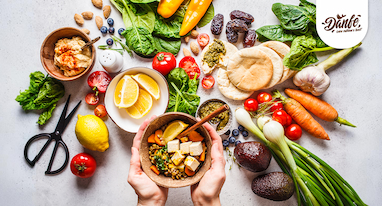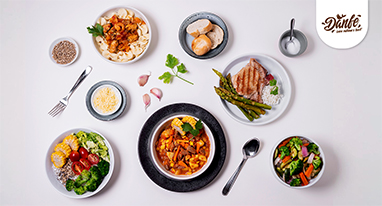What makes gluten-free bread different, its benefits, and how to bake it at home?
BY DANFE |
Finding the right gluten-free bread can be one of the most difficult parts of a gluten-free diet. Here’s what you need to know about gluten-free bread. How it’s made, what gluten-free flour can be used, and more.
It is a staple in most cultures, and each region has its own version of it. Being gluten-free limits your ability to enjoy bread, at least in its most traditional forms. Bread that is gluten-free does exist, and it can be just as satisfying as its wheat-based counterpart, but it has a few key differences.
How is gluten-free bread different?
When gluten-free bread is stacked next to traditional wheat bread, it may not look all that different on the outside. Naturally, this all depends on the type of flour used.
Here are some of the key elements to look for that make gluten-free bread different:
- Tastes are highly variable. One of the most challenging aspects of gluten-free bread is also its most characteristic – the fact that there are so many different flours to choose from, each with its unique taste. The taste and texture of wheat bread are fairly consistent.
- Wheat bread is less spongy than white bread: It is gluten, a protein found in wheat, barley, and rye, that gives baked goods their spongy texture. Gluten-free bread tends to be denser than wheat-based bread and some gluten-free flours have a gritty texture.
- Gluten-free bread has a short shelf life: Gluten-free bread goes stale more quickly when reheated, and it generally does not last as long as wheat-based bread. Many gluten-free loaves of bread are frozen or vacuum-sealed for this reason. It’s best to toast most bread unless they’re vacuum-sealed.
- They may not rise as much: Gluten-free bread doesn’t rise as much as wheat-based bread, so they have an airy texture. Gluten-free bread tends to have heavier ingredients.
- Gluten-free bread browns the same way as wheat-based bread: The signature of a beautiful bake is an evenly browned loaf, but gluten-free bread doesn’t always brown as consistently as wheat-based bread.
The benefits of homemade gluten-free bread can’t be ignored
1. Regulates Celiac Disease
Gluten intolerance or Celiac is an autoimmune disease characterized by a general intolerance to any protein derived from wheat, rye, barley, and oats. Now anyone who suffers from celiac disease can enjoy the taste of bread without worrying about it affecting their digestive system. Read on to find the recipe for easy gluten-free bread.
2. Promotes a Healthy Digestive Tract
Those with gluten intolerance can develop scar tissue and delayed gastric emptying as a result of attempting to digest gluten-containing foods, which results in unpleasant conditions like bloating and cramping.
Gluten-free bread, on the other hand, is easier on the digestive system. The nutrients in gluten-free bread are used fully and help the production of friendly bacteria in the intestines.
3. Maintains Freshness
A loaf of baked gluten-free bread will have the freshness and taste that is lacking in store-bought loaves, which are processed for longer shelf life and improved texture.
Gluten-free bread differs depending on the type of flour used. Here is the recipe for the best gluten-free bread you can use to bake at home.
Easy Gluten-Free Bread Recipe
[Source: Clean eating kitchen]
Bread lovers, rejoice. This gluten-free buckwheat bread is the real deal, with a soft, chewy open crumb and a deliciously crisp crust. It’s also super easy to prepare.
Ingredients
- 325 ml Almond milk
- 2 large free-range eggs
- 1 tsp white vinegar
- 450 g buckwheat flour
- ½ tsp salt
- 2 tbsp golden caster sugar
- 1½ x 6g sachet dried yeast
- 3 tbsp olive oil
Instructions
- Preheat the oven to 200ºC. Over low heat, warm the milk slightly, then allow it to cool. Stir in the warm milk gradually after cracking the eggs in a large bowl, then add the vinegar.
- In a separate bowl, combine the flour, salt, sugar, and yeast. Using a wooden spoon, stir the dry ingredients into the wet mixture until it forms a sticky dough. You can add a little flour if it is too sticky, then bring it together with your hands into a ball.
- The dough should be placed onto a lightly oiled baking tray, covered with a damp tea towel, and left to prove for around 1 hour, or until doubled in size.
- Bake the tray in the hot oven for approximately 35 minutes, or until golden and cooked through. Slice and serve after it has cooled slightly on a wire cooling rack. Delicious with stews and soups, or toasted and served with butter and jam.
Gluten-free bread is made with all sorts of grains and legumes which are naturally gluten-free, such as rice, almond, buckwheat, chickpea, sorghum, quinoa, and millet. You should choose gluten-free bread if you suffer from celiac disease, wheat sensitivities, or wheat allergies. These bread are also healthy and are best for promoting healthy digestion. You landed the right place for the best gluten-free bread recipe and everything you need to know about it.




